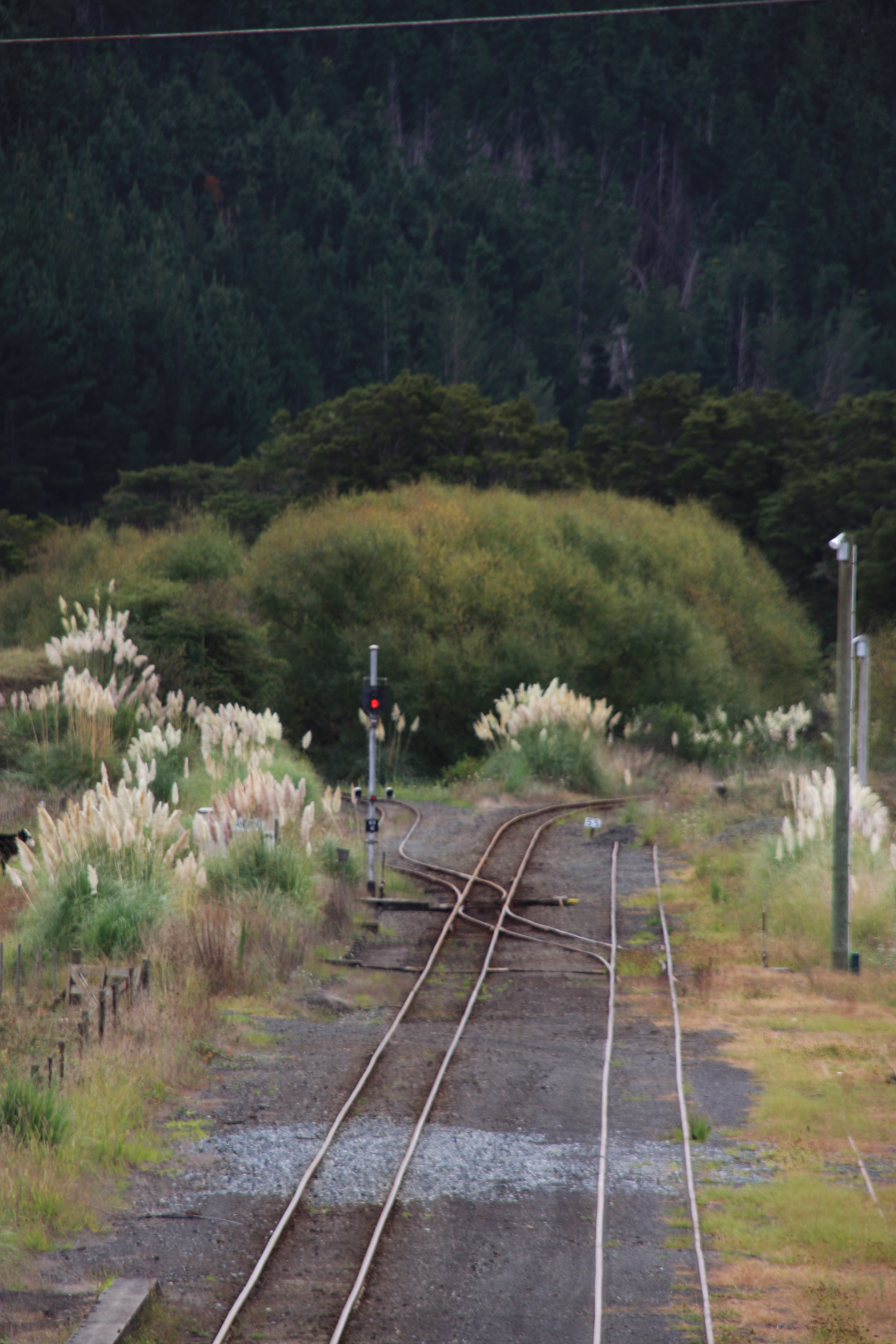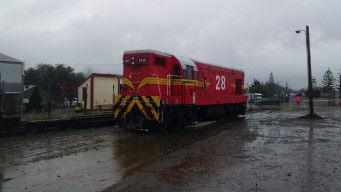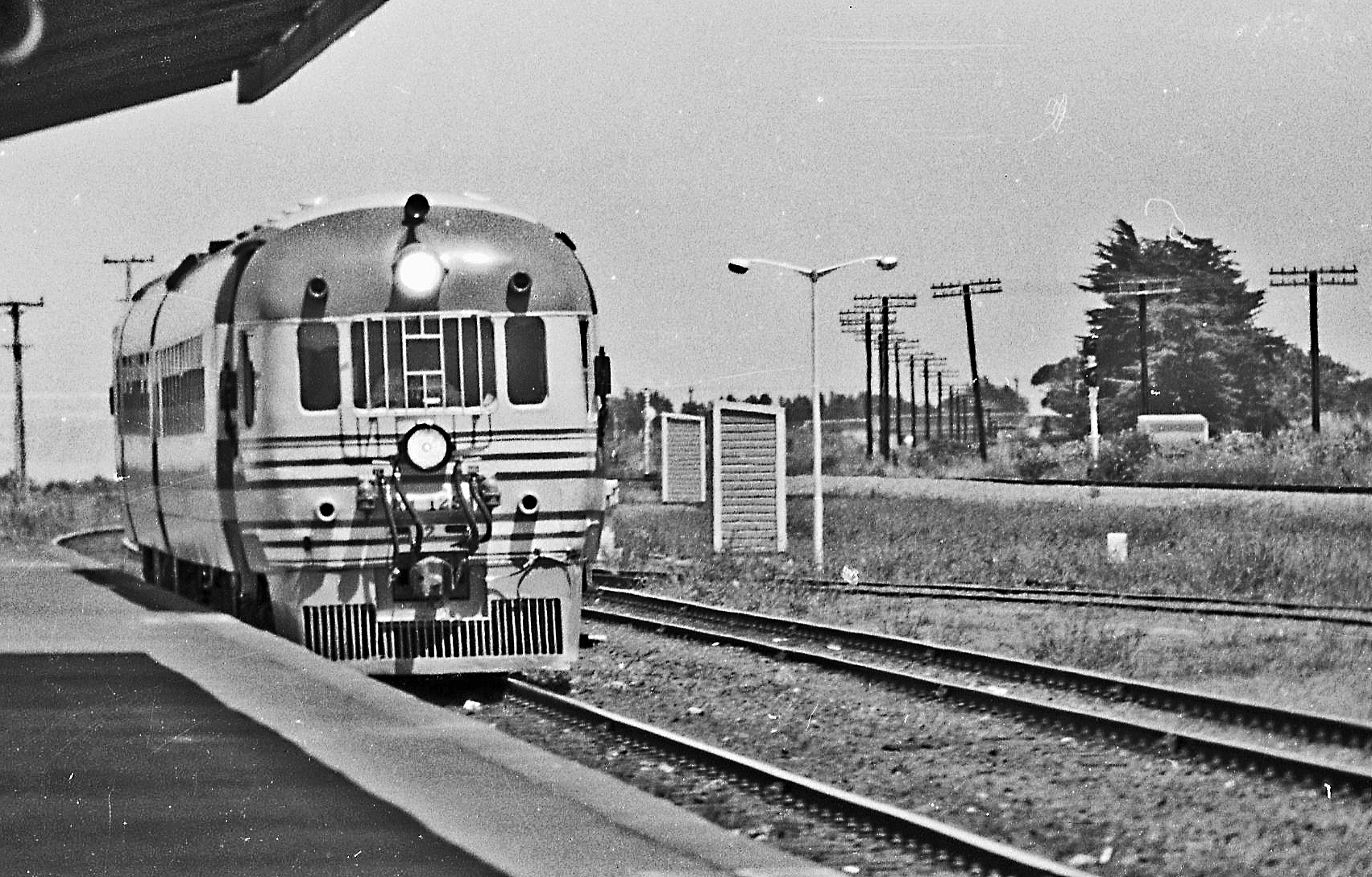|
Dargaville Branch
The Dargaville Branch is a branch line railway that leaves the North Auckland Line not far south of Whangarei and runs westward to Dargaville. Construction of this relatively short line took approximately two decades, and when it was completed, it linked the now closed Donnellys Crossing Section with the national rail network. The branch has been closed to all traffic since 2014 and is currently used by a tourist railcart operation. Construction The Dargaville Branch was built relatively late in comparison to most railway lines in New Zealand. Construction from Waiotira on the North Auckland Line commenced in 1922. Dargaville, however, was not reached for another eighteen years. The first twenty-two kilometres through unstable country took six years to build, with the line not opened to Kirikopuni until 15 May 1928. In January 1931, the line was open to Tangowahine, sixteen kilometres from Dargaville, but construction ceased for five years due to the Great Depression. ... [...More Info...] [...Related Items...] OR: [Wikipedia] [Google] [Baidu] |
Dargaville
Dargaville ( mi, Takiwira) is a town located in the North Island of New Zealand. It is situated on the bank of the Northern Wairoa River in the Kaipara District of the Northland region. The town is located 55 kilometres southwest of Whangārei. Dargaville is 174 kilometres north of Auckland. It is noted for the high proportion of residents of Croatian descent. The area around it is one of the chief regions in the country for cultivating kumara (sweet potato) and so Dargaville is known by many locals as the Kumara Capital of New Zealand. History and culture The town was named after timber merchant and politician Joseph Dargaville (1837–1896). Dargaville was founded in 1872, during the 19th-century kauri gum and timber trade, it briefly had New Zealand's largest population. Dargarville was made a borough in 1908. The area became known for a thriving industry that included gum digging and kauri logging, which was based mainly at Te Kōpuru, several kilometres south of Darg ... [...More Info...] [...Related Items...] OR: [Wikipedia] [Google] [Baidu] |
Mixed Train
A mixed train or mixed consist is a train that contains both passenger and freight cars or wagons. Although common in the early days of railways, by the 20th century they were largely confined to branch lines with little traffic. Typically, service was slower, because mixed trains usually involved the shunting (switching) of rolling stock at stops along the way. However, some earlier passenger expresses, which also hauled time-sensitive freight in covered goods wagons (boxcars), would now be termed mixed trains. Generally, toward the end of the mixed train era, shunting at intermediate stops had significantly diminished. Most railway passenger and freight services are now administered separately. Exclusions Not intended by this article is the definition of mixed train to describe: * mixed freight. * wagonload service (single wagons for various customers, assembled into trains), as opposed to trainload service (point to point, complete train for one customer). * a passenger trai ... [...More Info...] [...Related Items...] OR: [Wikipedia] [Google] [Baidu] |
New Zealand DJ Class Locomotive
The New Zealand DJ class locomotive is a type of diesel-electric locomotive A diesel locomotive is a type of railway locomotive in which the prime mover is a diesel engine. Several types of diesel locomotives have been developed, differing mainly in the means by which mechanical power is conveyed to the driving wheels ... in service on the New Zealand rail network. The class were built by Mitsubishi Heavy Industries and introduced from 1968 to 1969 for the New Zealand Railways Department (NZR) with a modernisation loan from the World Bank to replace steam locomotives in the South Island, where all of the class members worked most of their lives. Nine of the locomotives remain in use, mainly with Dunedin Railways. They are the second class of locomotive in New Zealand to utilise the Bo-Bo-Bo wheel arrangement, the other classes being the New Zealand EW class locomotive, EW class and the New Zealand EF class locomotive, EF class. In both cases, this wheel arrangement was used ... [...More Info...] [...Related Items...] OR: [Wikipedia] [Google] [Baidu] |
New Zealand DA Class Locomotive
The New Zealand DA class locomotive were a class of diesel-electric mainline locomotives operated on the New Zealand railway system between 1955 and 1989. Consisting of 146 locomotives, it was the most numerous class to ever operate in New Zealand, with five more than the AB class steam locomotive. The class were A1A-A1A versions of the Electro-Motive Diesel G12 model, with the design altered slightly to run on New Zealand's rail system, and fit the small loading gauge. They were introduced between 1955 and 1967 in three phases and were the first class of diesel locomotives to seriously displace steam traction. Between 1978 and 1983, 85 locomotives were rebuilt as the DC class, of which some are still in use. All but one of the remainder were withdrawn by 1989, with six preserved. The last locomotive was refitted for shunting duties and was rebuilt as DAR 517. Introduction The DA class have their origins in the post World War II period. Like most nations New Zealand's dom ... [...More Info...] [...Related Items...] OR: [Wikipedia] [Google] [Baidu] |
NZR J Class (1939)
The New Zealand Railways Department, NZR J class steam locomotives were a type of 4-8-2 steam locomotive built for the New Zealand Railways Department (NZR) and used on the Rail transport in New Zealand, New Zealand railway network. Built by the North British Locomotive Works, although designed to work on the lighter secondary lines the class was frequently used on mainline express passenger trains as well as freight. The class first appeared in distinctive streamlining, which was later removed from 1947 onwards for maintenance reasons. The class should not be confused with the earlier 1874 NZR J class (1874), J class. Three J class lasted until the end of steam-hauled services on 26 October 1971, three locomotives of the forty built have been preserved. History The J class were primarily designed to provide a mixed traffic locomotive more powerful than the AB class that was capable of running on the lighter secondary lines of the New Zealand Railways network, but was equally cap ... [...More Info...] [...Related Items...] OR: [Wikipedia] [Google] [Baidu] |
NZR Ab Class
The NZR AB class was a class of 4-6-2 Pacific tender steam locomotive that operated on New Zealand's national railway system for New Zealand Railways (NZR). Originally an improvement on the 1906 A class, 141 were built between 1915 and 1927 by NZR's Addington Workshops, A & G Price of Thames, New Zealand, and North British Locomotive Company, making the AB class the largest class of steam locomotives ever to run in New Zealand. An additional eleven were rebuilt from the tank version of the AB – the WAB class – between 1947 and 1957. Two North British-made locomotives were lost in the wreck of the ''SS Wiltshire'' in May 1922. Construction and design The genesis of the AB class originated from the construction of A class 4-6-2 No. 409 at Addington Railway Workshops in 1906. A two-cylinder simple-expansion locomotive, 409 was initially classified AB to differentiate it from the four-cylinder compound A and AD class locomotives, which were by and large of a similar design ... [...More Info...] [...Related Items...] OR: [Wikipedia] [Google] [Baidu] |
Steam Locomotive
A steam locomotive is a locomotive that provides the force to move itself and other vehicles by means of the expansion of steam. It is fuelled by burning combustible material (usually coal, oil or, rarely, wood) to heat water in the locomotive's boiler to the point where it becomes gaseous and its volume increases 1,700 times. Functionally, it is a steam engine on wheels. In most locomotives, the steam is admitted alternately to each end of its cylinders, in which pistons are mechanically connected to the locomotive's main wheels. Fuel and water supplies are usually carried with the locomotive, either on the locomotive itself or in a tender coupled to it. Variations in this general design include electrically-powered boilers, turbines in place of pistons, and using steam generated externally. Steam locomotives were first developed in the United Kingdom during the early 19th century and used for railway transport until the middle of the 20th century. Richard Trevithick ... [...More Info...] [...Related Items...] OR: [Wikipedia] [Google] [Baidu] |
Dargaville Rail Carts 2
Dargaville ( mi, Takiwira) is a town located in the North Island of New Zealand. It is situated on the bank of the Northern Wairoa River in the Kaipara District of the Northland region. The town is located 55 kilometres southwest of Whangārei. Dargaville is 174 kilometres north of Auckland. It is noted for the high proportion of residents of Croatian descent. The area around it is one of the chief regions in the country for cultivating kumara (sweet potato) and so Dargaville is known by many locals as the Kumara Capital of New Zealand. History and culture The town was named after timber merchant and politician Joseph Dargaville (1837–1896). Dargaville was founded in 1872, during the 19th-century kauri gum and timber trade, it briefly had New Zealand's largest population. Dargarville was made a borough in 1908. The area became known for a thriving industry that included gum digging and kauri logging, which was based mainly at Te Kōpuru, several kilometres south of ... [...More Info...] [...Related Items...] OR: [Wikipedia] [Google] [Baidu] |
Dargaville Rail Carts 1
Dargaville ( mi, Takiwira) is a town located in the North Island of New Zealand. It is situated on the bank of the Northern Wairoa River in the Kaipara District of the Northland region. The town is located 55 kilometres southwest of Whangārei. Dargaville is 174 kilometres north of Auckland. It is noted for the high proportion of residents of Croatian descent. The area around it is one of the chief regions in the country for cultivating kumara (sweet potato) and so Dargaville is known by many locals as the Kumara Capital of New Zealand. History and culture The town was named after timber merchant and politician Joseph Dargaville (1837–1896). Dargaville was founded in 1872, during the 19th-century kauri gum and timber trade, it briefly had New Zealand's largest population. Dargarville was made a borough in 1908. The area became known for a thriving industry that included gum digging and kauri logging, which was based mainly at Te Kōpuru, several kilometres south of ... [...More Info...] [...Related Items...] OR: [Wikipedia] [Google] [Baidu] |
Railcar
A railcar (not to be confused with a railway car) is a self-propelled railway vehicle designed to transport passengers. The term "railcar" is usually used in reference to a train consisting of a single coach (carriage, car), with a driver's cab at one or both ends. Some railway companies, such as the Great Western, termed such vehicles "railmotors" (or "rail motors"). Self-propelled passenger vehicles also capable of hauling a train are, in technical rail usage, more usually called "rail motor coaches" or "motor cars" (not to be confused with the motor cars, otherwise known as automobiles, that operate on roads). The term is sometimes also used as an alternative name for the small types of multiple unit which consist of more than one coach. That is the general usage nowadays in Ireland when referring to any diesel multiple unit (DMU), or in some cases electric multiple unit (EMU). In North America the term "railcar" has a much broader sense and can be used (as an abbr ... [...More Info...] [...Related Items...] OR: [Wikipedia] [Google] [Baidu] |
NZR RM Class (88 Seater)
The NZR RM class 88-seaters were a class of railcar used in New Zealand. New Zealand Government Railways (NZR) classified them as RM (Rail Motor), the notation used for all railcars, numbering the 35 sets from RM100 to RM134. They were the most numerous railcars in NZR service. Their purchase and introduction saw the demise of steam-hauled provincial passenger trains and mixed trains, and was part of a deliberate effort to modernise NZR passenger services at a time of increasing competition from private motor vehicles. Being diesel powered and lighter the railcars were less expensive to operate and able to maintain quicker timetables, although became plagued with mechanical and electrical problems, with a number of the class eventually being turned into depowered locomotive-hauled carriages and reclassified as the AC class "Grassgrubs". Background In the early 1950s, NZR was in the process of replacing steam traction with diesel and modernising the railways to cope with vastly i ... [...More Info...] [...Related Items...] OR: [Wikipedia] [Google] [Baidu] |



.jpg)

.jpg)
